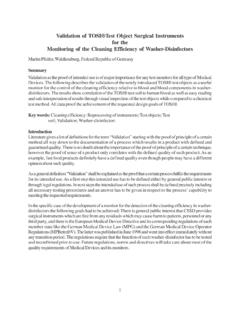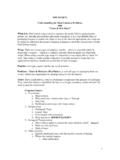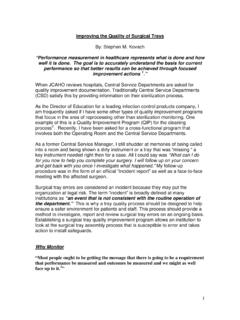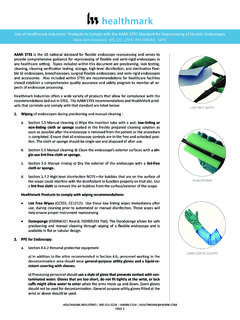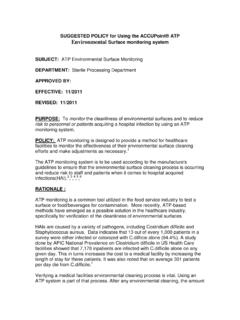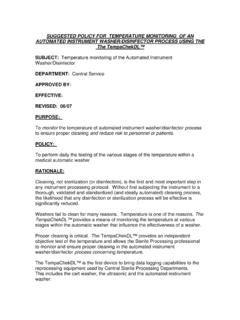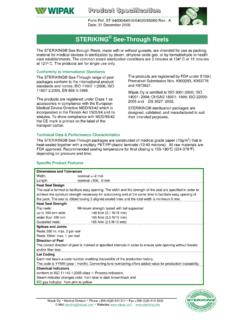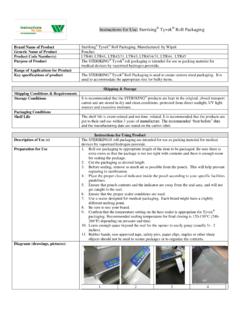Transcription of SUBJECT: Automated Instrument Washer Cleaning …
1 SUGGESTED POLICY FOR MONITORING THE Cleaning EFFICIENCY OF AN Automated Instrument Washer /DISINFECTOR PROCESS USING THE Blood Soil Test( Daily & weekly Testing) SUBJECT: Medical Automated Instrument Washer /Disinfector Cleaning Monitoring DEPARTMENT: Central Service APPROVED BY: EFFECTIVE: REVISED: 11/2010 PURPOSE: To monitor the Automated Instrument Washer /disinfector process to ensure proper Cleaning and reduce risk to personnel or patients. (1, 10, 12, 13) POLICY: This policy is for inspection and testing on a daily basis of the medical automatic Washer with the blood soil test.
2 The blood soil test is to be used according to the manufacturer's guidelines to ensure that the Cleaning process is occurring and the Automated Instrument Washer is functioning properly. (1, 6, 7, 8, 9, 10, 12, 13) RATIONALE: "A problem analysis should be completed for any problem with any aspect of decontamination that can pose a risk to personnel or patients. The problem analysis should define and resolve the problem and the system should be monitored to ensure that the problem has been corrected"(1). ST 79; 2009A section states this on weekly testing.
3 Mechanical Cleaning equipment should be tested upon installation, weekly (preferably daily) during routine use, and after major repairs. A major repair is a repair that is outside the scope of routine preventive maintenance and that significantly affects the performance of the equipment. Examples include replacement of the water pump(s), detergent delivery system, heating system, water delivery system, water treatment system, or computer control or an upgrade to 1 The 2006 JCAHO standard states that all medical equipment is maintained, tested and inspected.
4 The 2008 AORN RP for Cleaning and Care of surgical instruments and Powered Equipment Recommendation XXII Quality section is now supporting the testing of mechanical Instrument washers before initial use, weekly during service, and after major maintenance. (1, 12) The medical automatic Washer is considered a piece of medical equipment. Medical washers need to be properly functioning to provide the best patient care possible and to help reduce the incidence of hospital-acquired infections " Cleaning , not sterilization (or disinfection), is the first and most important step in any Instrument processing protocol.
5 Without first subjecting the Instrument to a thorough, validated and standardized (and ideally Automated ) Cleaning process, the likelihood that any disinfection or sterilization process will be effective is significantly reduced." (11,13) An Automated Washer /disinfector cleans and decontaminates dirty surgical instruments so they can be handled safely, repackaged, and sterilized for a future surgery. The danger of handling instruments contaminated with blood is obvious in this age of hepatitis, CJD and HIV. The procedures for sterilizing instruments are based on years of scientific testing of Cleaning instruments .
6 If surgical instruments are not clean, the procedures are ineffective. Dried blood on instruments is hazardous to the employees of the hospital and to the next surgical patient upon which the instruments are used. (1, 2, 3, 4, 8, 13) Cleaning dried blood is much more difficult than Cleaning dirt. Blood coagulates, which means it goes from a free-flowing liquid to a solid that contains tough, microscopic fibers called fibrin. These fibers form as the blood coagulates and jam themselves into microscopic irregularities in the surface of the stainless steel Instrument .
7 This is a physical attachment to the surface through mechanical means, not chemical means as with traditional adhesives. The action is similar to the roots of plants growing into cracks in rocks, anchoring themselves to the surface. The blood cells colored with hemoglobin are fairly easy to wash off instruments , but the clear fibrin material is much more difficult to remove. Thick droplets of dried blood have so much fibrin; even the colored hemoglobin can be trapped and held in place. (3, 4, 13) Another factor that makes blood difficult to clean is its ability to become insoluble when heated.
8 Heating causes blood to denature.". Denaturing is similar to what happens to eggs cooked in a frying pan. Transparent uncooked egg whites are fairly easy to wash away, but opaque, cooked egg whites are much more difficult. 2 Dried, uncooked egg is even more difficult to wash away, as is dried blood. The proteins in blood are similar to albumin proteins in eggs. Washers fail to clean for many reasons. Tests should provide a means of monitoring the variables that influence the effectiveness of a Washer . Some of these variables are water quality, time, detergent, enzyme, temperature, pH level, agitation, speed, initial temperature, drying time, obstructions, and insufficient amount of chemicals.
9 (7, 13) Proper Cleaning is critical. The blood soil provides an independent objective test of clean and allows the Healthcare professional to monitor and ensure proper Cleaning in the Automated Instrument Washer /disinfector process. (1) JCAHO, AAMI, AORN, IAHCSMM recommend that Sterile Processing departments have process performance in place (1, 5, 12, 13). The FDA, AAMI and other regulatory bodies recommend that any simulated-use testing be done with a surrogate device that closely approximates the actual types of soils the Instrument is to be exposed to in clinical use.
10 Further, the surrogate device should be made of the same type of material as the Instrument it represents Using the blood soil test according to the manufacturer's guidelines helps ensure adherence to all guidelines and standards and thus a properly functioning Cleaning process PROCEDURE: "A problem analysis should be completed for any problem with any aspect of decontamination that can pose a risk to personnel or patients. The problem analysis should define and resolve the problem and the system should be monitored to ensure that the problem has been corrected.
